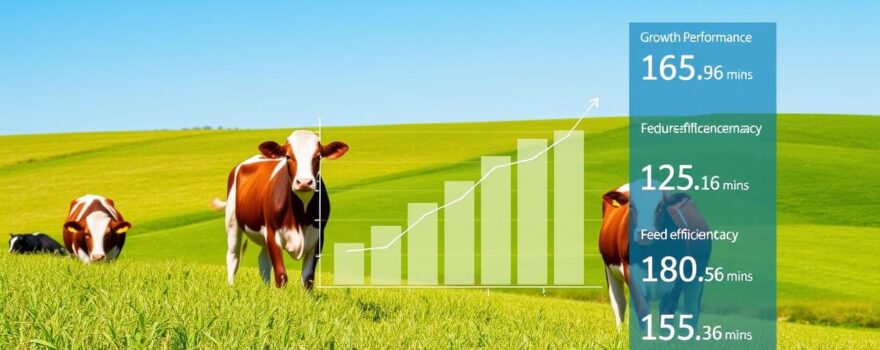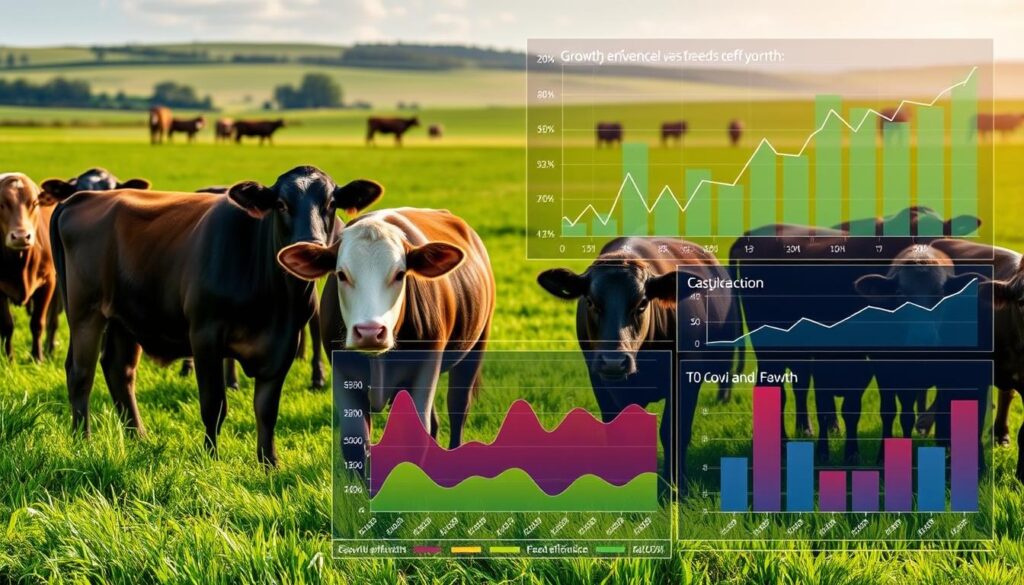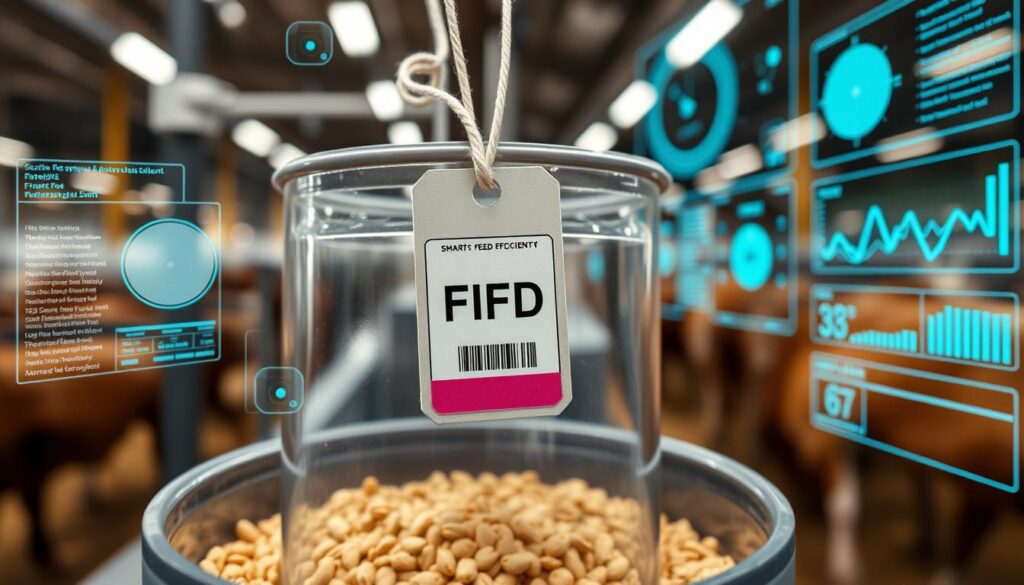
Improving feed efficiency is key for cattle farmers to cut costs and improve herd quality. The Feed Conversion Ratio (FCR) shows how much feed an animal needs to gain weight. Beef cattle, being ruminants, have a poor FCR, averaging around 6:1. Using growth performance data to better feed efficiency can greatly increase profits and sustainability.
By looking at growth data like average daily gain and body weight monitoring, farmers can spot ways to use feed better. With tools like feed intake tracking and nutrition management software, they can make smart choices. This leads to better feedlot operations and the use of precision livestock farming to boost feed efficiency.
Key Takeaways
- Feed efficiency, measured by the Feed Conversion Ratio (FCR), is crucial for cattle producers to reduce costs and improve herd quality.
- Analyzing growth performance data, such as average daily gain and body weight, can help identify opportunities to enhance feed utilization.
- Leveraging feed intake tracking and nutrition management software enables data-driven decisions for optimizing feedlot operations and adopting precision livestock farming techniques.
- Improving feed efficiency can significantly boost profitability and sustainability in cattle production.
- Integrating growth performance data into feed management strategies is a powerful way to optimize feed efficiency and drive overall operational efficiency.
What is Feed Efficiency and Why It Matters
Feed efficiency is key in cattle farming. It shows how well an animal turns feed into growth or output. A better feed efficiency means less feed is needed for the same growth. This cuts costs, as feed is a big expense in cattle farming.
Understanding the Impact of Feed Efficiency on Profitability
Boosting feed efficiency can slash feed costs and boost profits. Up to 45% of feed is wasted or not fully used. Better feed efficiency means more money from each feed dollar spent.
The Role of Feed Efficiency in Sustainable Farming
Feed efficiency also helps farming be more sustainable. It uses less feed and cuts down on environmental harm. Using tech like automated feeders and RFID tags makes farming more efficient. This leads to healthier animals and less waste and pollution.
| Metric | Ideal Range | Significance |
|---|---|---|
| Feed Conversion Ratio (FCR) | 1.2 – 1.8 | A lower FCR means better feed efficiency. The animal needs less feed to gain weight. |
| Residual Feed Intake (RFI) | Lower RFI | Animals with lower RFI are more efficient. They eat less than expected for their size and growth. |
Improving feed efficiency is vital for sustainable farming. It boosts profits and helps the farming industry stay sustainable.
Key Metrics for Evaluating Feed Efficiency
When it comes to improving feed efficiency in cattle, two key metrics are important: Feed Conversion Ratio (FCR) and Residual Feed Intake (RFI). These metrics help us understand how well animals turn feed into growth. This knowledge helps producers make better choices and improve their herd’s performance.
Feed Conversion Ratio (FCR)
The Feed Conversion Ratio is a well-known way to measure feed efficiency. It’s the amount of feed an animal eats compared to how much it gains in weight. A lower FCR means an animal is more efficient, needing less feed to gain weight. This metric is key in the cattle world for judging animal performance and comparing different feeding methods.
Residual Feed Intake (RFI)
Residual Feed Intake is a more advanced way to look at feed efficiency. It takes into account an animal’s expected feed intake based on its size and growth rate. This gives a clearer picture of an animal’s efficiency. Animals with a lower RFI are more efficient because they eat less than expected to achieve the same performance.
To use FCR and RFI, you need precise data on how much each animal eats and grows. This data can come from RFID systems and electronic scales. By using these metrics, cattle producers can make smart choices to boost their herd’s performance and profits.
“Residual Feed Intake is considered the gold standard of feed efficiency, showing that cattle with lower RFI values are more efficient in feed utilization compared to those with higher RFI values.”
How to Use Growth Performance Data to Optimize Feed Efficiency
Cattle producers can unlock the secrets to optimizing feed efficiency by closely analyzing growth performance data. Key metrics such as individual animal feed intake, body weight, and average daily gain provide valuable insights. These insights inform strategic decisions around nutrition management.
By calculating feed conversion ratio (FCR) and residual feed intake (RFI), producers can identify the most and least feed-efficient animals within their herd. Armed with this data-driven knowledge, they can make targeted adjustments. These adjustments include feed formulations, feeding protocols, and genetic selection. This drives meaningful improvements in overall herd feed efficiency.
| Metric | Description | Impact on Feed Efficiency |
|---|---|---|
| Feed Conversion Ratio (FCR) | The ratio of feed consumed to live weight gained, typically ranging from 4.5:1 to 7.5:1 for beef cattle with an average of 6:1. | Lower FCR indicates more efficient conversion of feed into growth, reducing feed costs and improving profitability. |
| Residual Feed Intake (RFI) | The difference between an animal’s actual feed intake and its expected intake based on body weight and growth rate. | Animals with a lower (negative) RFI are more feed efficient, consuming less feed than expected for their size and growth. |
Leveraging growth performance data is essential for making data-driven improvements to cattle nutrition management and boosting the profitability of the operation. By investing in systems like SmartFeed and SmartScale, producers can accurately measure individual animal feed intake and weight data. This empowers them to optimize feed efficiency and identify the most efficient animals in their herd.

“Optimizing feed efficiency can lead to cost reduction and improved profitability in beef cattle production, as well as benefiting the overall health of the herd.”
Assessing Your Current Feed Management Practices
The first step to better feed efficiency is to check your feed management practices. Look at how well your animals use the feed. This can be done by tracking feed utilization and animal performance. Also, calculate your farm’s Feed Conversion Ratio (FCR) and compare it to others in the industry.
Evaluating Feed Utilization and Animal Performance
Watch how much your livestock eats, how fast they grow, and their health. This helps you understand feed utilization and animal performance. Even a small improvement in FCR can mean a big increase in profit for farmers.
Analyzing Feed Quality and Storage Practices
Look at the quality of your feed. Make sure it’s right for your animals and stored well. Good storage keeps the feed quality high. Check your feed storage often to cut down on waste and boost feed efficiency.
By analyzing your feed management practices, you can find ways to make your livestock operation more profitable.
Implementing Best Practices for Maximizing Feed Efficiency
Improving feed efficiency is key for any farm, as feed costs can be over 50% of expenses. By using the best methods, farmers can boost their profits and feed their cattle well.
Selecting the Right Feed for Your Livestock
First, choose the right feed for your cattle. Make sure it has the right mix of protein, energy, and fiber. High-quality forages are essential for good and affordable food for your dairy cows.
Testing your forages regularly is important. It helps you know their nutritional value. This leads to better feed efficiency.
Implementing Proper Feeding Techniques and Protocols
- Manage bunk refusals to below 2% for lactating cows to contribute to cost-saving, improved nutrient efficiency, and milk yield.
- Group cows according to production levels and nutritional needs to enhance nutrient utilization and herd health.
- Sustain rumen health, as it is essential for dairy cow feed efficiency, improving digestion and feed utilization.
- Monitor data such as milk production, health parameters, and consumption patterns to detect performance issues and adjust feeding strategies.
| Best Practices for Feed Efficiency | Potential Benefits |
|---|---|
| Precision feed management | Up to 25% increase in overall farm profitability |
| Strict adherence to feed standards | 15% increase in feed conversion rates |
| Regular feed consumption checks | Up to 20% reduction in feed wastage |
By picking the right feed and using smart feeding methods, you can greatly improve your cattle’s feed efficiency. This will help you make more money.
The Role of Technology in Enhancing Feed Efficiency
Technology plays a big role in improving feed efficiency. Automated feeding systems and precision feeding tools like RFID-enabled feeders and electronic scales are key. They help manage livestock feed better.
Automated Feeding Systems and Precision Feeding Equipment
Automated feeding systems use advanced tech to manage feed delivery. They use RFID tags to track how much each animal eats. This lets farmers monitor and control feed closely.
With precision feeding tools like electronic scales, farmers can watch animal weight in real time. This helps them adjust feed rations for each animal. It ensures each gets the right nutrients for growth and better feed use.
| Technology | Benefits for Feed Efficiency |
|---|---|
| RFID-enabled Feeders | Accurate tracking of individual feed intake, reduced feed waste |
| Electronic Scales | Precise monitoring of animal weight, enabling tailored feed rations |
These technologies give farmers insights into their animals’ eating habits and growth. This data helps them make better choices. It leads to more efficient feed use and better cattle operations.

“Precision feeding technologies have the potential to transform the livestock industry by enabling farmers to make data-driven decisions that optimize feed efficiency and profitability.”
Managing Waste and By-Products Effectively
Managing feed waste and by-products is key to better feed efficiency and sustainable farming. By using the leftovers from feed storage and production, farmers can make valuable products. These include fertilizers, soil conditioners, and other feed ingredients. This approach not only cuts down on waste but also brings in more money and helps the environment.
Studies show that food transport is a big part of greenhouse gas emissions, making up nearly 20% of food-systems emissions. Using waste for energy and following Sustainable Development Goals in dairy farming shows how we can change things. Agro-industrial side-streams are being turned into healthy foods, showing the power of innovation.
There’s a big push worldwide to recycle food waste for a better economy. Food waste is being turned into bioplastics, and black soldier fly larvae are being looked at as a new protein source. These steps show the industry’s move towards better waste management and finding new, sustainable feed sources.
By adopting full waste management plans, cattle farmers can make their operations more efficient and green. This not only helps the environment but also brings in more income and keeps farms running strong for years to come.
“The livestock industry, including poultry and fish, contributes to over 40% of the total agricultural sector in India, and by-products of cattle, pigs, and lambs represent a significant portion of the live weight.”
The Importance of Staff Education and Training
Teaching your farm staff about feed efficiency is key to success. Make sure they know why feed efficiency matters, the important metrics, and how they can help. Encourage them to find ways to improve and share new ideas. A well-trained team will stick to good feed management practices, helping your farm grow sustainably.
Spending on staff education and feed efficiency training boosts your farm’s success. It helps your team make smart choices, use feed wisely, and adopt sustainable farming practices. This benefits your farm and the environment.
A good training program covers many topics. It includes:
- Learning about feed efficiency and its impact on your farm’s success
- Understanding key metrics like Feed Conversion Ratio (FCR) and Residual Feed Intake (RFI)
- Learning best practices for managing, storing, and distributing feed
- Identifying factors that affect feed efficiency, like animal health and environment
- Exploring new technologies and strategies for better feed efficiency
- Creating a culture of continuous improvement and idea sharing
By investing in your staff’s education and training, you unlock your farm’s full potential. This drives sustainable growth and sets your business up for long-term success in agriculture.
| Training Type | Objectives and Benefits |
|---|---|
| New Hire Training | Equips employees with the necessary skills to perform their duties successfully. |
| Leadership Training | Develops leadership skills like effective communication and decision-making. |
| Compliance Training | Covers topics such as workplace safety, data privacy, and industry-specific regulations. |
| Technical Training | Focuses on developing technical competencies for specific job functions. |
| Product Training | Provides a comprehensive understanding of a company’s offerings, including features and benefits. |
| Sales Training | Focuses on product knowledge, communication abilities, and closing strategies. |
| Anti-bias and Diversity Training | Aims to cultivate inclusivity and reduce bias. |
| Gamification Training | Incorporates game-like elements to increase participation and motivation. |
| Soft Skills Development | Enhances communication, productivity, and job satisfaction. |
| Quality Assurance Training | Ensures products meet customer needs and regulatory requirements. |
| Change Management Training | Helps individuals and organizations navigate change effectively. |
| Stress Management Training | Reduces the negative impact of stress on physical and mental health. |
| Time Management Training | Increases productivity and improves work-life balance. |
By focusing on staff education and feed efficiency training, you build a knowledgeable and motivated team. This drives your farm’s success and sustainability.
“Investing in the education and development of our employees is not only the right thing to do, but it also directly contributes to the long-term success and sustainability of our farm. When our team is equipped with the knowledge and skills to optimize feed efficiency, they become empowered to make a real difference in our operation’s profitability and environmental stewardship.”
Genetic Selection for Feed-Efficient Livestock
Choosing cattle that are genetically feed efficient is key to better feed use. Scientists have found important genetic factors that help with feed efficiency. They use Residual Feed Intake (RFI) to find and breed the best animals.
By picking animals with good RFI and feed conversion ratios, you can make your herd more efficient. This makes your cattle operation more profitable and sustainable.
Studies show that certain traits, like how long animals eat, are important for feed efficiency. These traits are linked to RFI and feed conversion ratio (FCR). This means you can focus on breeding for these traits.
Breeding for Improved Feed Conversion Ratios
Adding genetic selection to your breeding program can make your cattle operation more profitable. By choosing animals with better feed conversion ratios and low RFI, you can make your herd more efficient. This saves resources and cuts down on feed costs.
To do this, use genetic data and performance records to find the most efficient animals. Then, breed them to pass on these traits. This method can lead to better feed efficiency, less environmental impact, and more profit for your cattle business.
“By identifying and breeding animals with favorable RFI and feed conversion ratios, producers can enhance the inherent feed-efficient characteristics of their herd over time.”
Growth Promotants and Their Impact on Feed Efficiency
Livestock producers use growth promotants to boost productivity and feed efficiency. These include ionophores, hormone implants, and beta-adrenergic agonists. They significantly improve cattle’s feed efficiency and performance.
Ionophores and Their Benefits
Ionophores are antimicrobial additives that change the rumen environment. They make nutrients more available and cut down methane emissions. Studies show ionophores can reduce greenhouse gas emissions by 28% per pound of weight gain.
They can be used at any stage of a beef animal’s life. This boosts feed efficiency and makes production more sustainable.
Hormone Growth Promotant Implants
Hormone implants help animals gain weight by promoting protein and reducing fat. This leads to better weight gain and feed use. Research shows these implants can feed 1.66 more U.S. citizens per animal than without them.
Beta-Adrenergic Agonists
Beta-agonists are the newest growth promotants. They increase protein, growth rate, and leaner carcasses. Used with other technologies, they greatly improve production efficiency, especially in finishing phases.
Despite some concerns, studies prove growth promotants enhance feed efficiency and reduce environmental impacts. Used responsibly, they are key to sustainable and profitable beef production.
Improving feed efficiency is key to successful cattle farming. By using growth data to check your feed practices, you can do better. This makes your farm more profitable and sustainable.
Using data to guide your feed efficiency efforts is smart. It helps you see how well your feeding program works. This lets you make better choices and improve your farm’s performance.
Choosing the right feed and using the latest technology are important. A good feed efficiency plan can greatly benefit your farm. It helps your farm stay profitable and sustainable for the future.